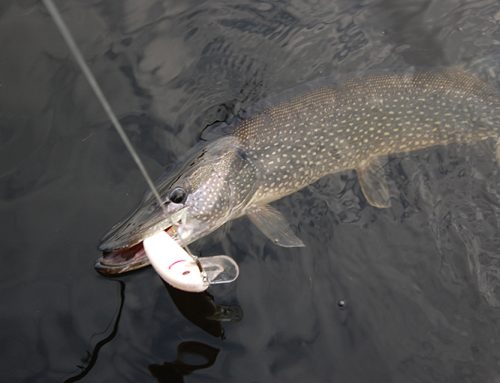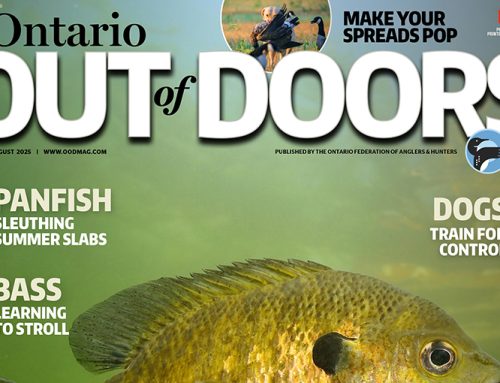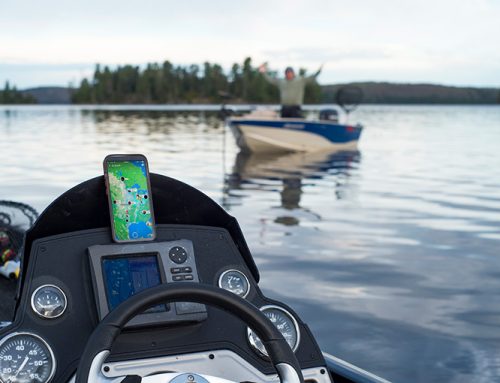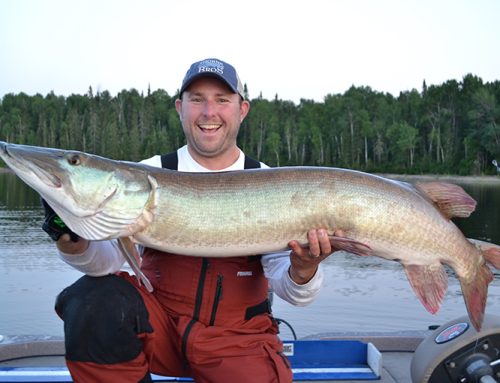
Eleven years ago, the late Bernie Schneiders wrote “Lake Superior’s Monster Pike” for the February issue of this publication. I remember the piece well, as it was one of the few articles I’d ever seen on the pike fishery in the big lake. He wrote that, in his youth, he’d seen trophy pike in the Kaministiquia River, a tributary of Lake Superior near Thunder Bay, but couldn’t catch them. He went on to detail some impressive pike fishing experiences he’d had on Superior as an adult angler.
Like Bernie, I grew up in Thunder Bay, and as a youth, remember catching pike offshore in the city’s harbour. The hot spots back in the 1970s and early 1980s included Perry’s Dock, near the mouth of McVicar Creek, and the estuary at the mouth of the Current River. The pike were decent, but rarely more than five or six pounds. In 1980, I recall fishing off a bridge at the Current River and seeing an angler in a canoe working the bay. He came to shore with a pike that looked to be about 4 feet long and weighing more than 20 pounds. That’s when it dawned on me that Lake Superior had trophy pike potential.
While there have always been trophy pike in Superior, they’ve not always been plentiful. The pike population in Thunder Bay’s harbour started to nose dive in the 1980s and the decline continued through most of the 1990s. Pike in Black Bay and Nipigon Bay were also relatively scarce for many years. The reasons are hard to get a handle on, but pollution almost certainly played a role, as did commercial fishing, and likely overharvesting by anglers. In the past decade, however, the numbers of pike seem to be growing all over the north shore of Lake Superior, and today in some places, trophy pike fishing is about as good as it gets. So, it seemed like a good time to revisit the subject Bernie Schneiders wrote about more than a decade ago.
Testing the waters
In the spring of 2012, some angling friends and I ventured out on exploratory fishing trips to Thunder Bay, Nipigon Bay, and Black Bay. It was the first time in years that any of us had targeted pike in Superior. One May afternoon, Sandro Fragale, my son Devin, and I fished a shallow spawning bay north of Thunder Bay. It was new ground for us, and my expectations were low. Yet, as we motored into the bay, I could see puffs of mud where large pike were spooking away from the boat.
Using the trolling motor, we snuck around and sighted several submarine shaped gators. Casting light plastic jerkbaits, shallow-running cranks, and bucktails, we experienced the kind of fishing you normally only get in remote fly-in lakes. It was simply superb. We caught and released about 20 pike between 30 and 44 inches that day. On subsequent trips to several locales, the fishing was rarely less than excellent. It’s my belief that trophy pike angling in Lake Superior is approaching the best in North America.
Location
Lake Superior is the largest freshwater lake in the world by area, and is amongst the world’s coldest and deepest lakes. This is both good and bad for pike. The lake has an average depth of 500 feet (you read right) and is over 1,300 feet at its deepest, so pike habitat is limited. Anglers need to look for shallow bays, river-mouth estuaries, and weedbeds to consistently locate pike in Lake Superior.
That doesn’t mean you won’t find pike in rocky, slightly deeper water, however. Over the years, many big pike have shown themselves while I’ve been casting or trolling for coaster brook trout, steelhead, and lakers in Superior. Last spring, while trolling for steelhead near the mouth of the Nipigon River, roughly two thirds of our hook-ups were pike grabbing our crankbaits. Some of these fish were large, post-spawn battlers. Almost all had significant marks on them from aggressive spawning behaviour. One 40-inch pike had a bite mark that spanned both sides of its body. That attacker must have been a big fish indeed.
Timing
Pike spawn at ice-out in most Ontario lakes, but it seems that the fish hit the shallows a little later in Superior. The lake had a much earlier ice-out than normal in 2012, but several weeks later, pike were visibly spawning in shallow bays. This makes for a larger window of opportunity for pike anglers, and it means you have a better chance at hooking up with a true giant.
Early last June while on a walk, Sami Leach, of Thunder Bay, saw some big pike cruising around the weedy shallows of the city’s marina. An avid angler, she and her husband, Jesse, returned with fishing rods in hand. Right at dark, Sami hooked into an enormous pike using a floating Rapala. The fish was landed, quickly photographed, and released. The big girl measured 44 inches, and from the look of the photos, she may not yet have spawned.
The mouths of streams and rivers are often magnets for Lake Superior pike. The river water is generally warmer than the frigid main lake, and the estuaries provide weeds for spawning. They also hold smelt, whitefish, perch, and suckers, all primary forage for pike. Shallow, weedy bays aren’t common on Lake Superior, but most bays hold pike at some point. Really large bays that are exceptionally shallow — Pigeon Bay and Black Bay fill this bill — also have a lot more pike than cold, clear, rocky areas. In the spring, pike will be found close to reeds and weeds, and in warmer inshore waters. However, as spring turns to summer, the truly giant pike will start moving offshore into cooler temperatures. In Black Bay, that could be many miles out. In deeper waters, such as those in Thunder Bay’s harbour, the pike will seek the deep weeds, or hold in the shadows of industrial docks and grain elevators.
In the late summer and fall, Lake Superior pike will move back into their spring haunts, though not quite as shallow. At the same time, large rivers, such as the Kaministiquia, Nipigon, and Pic, are magnets for big pike, especially as pink salmon, cisco, and whitefish start spawning runs. Little is known about the movements of pike in Superior, and there is almost no fishing pressure for them at this time of year.
My only consistent winter success for Superior pike has been on the Kaministiquia River. Over the years, I’ve fished the oxbow near Fort William Historical Park in late February and March. This is a spawning area for pike and they start staging early. I’ve iced a few really big pike here, but I will never forget hooking a monster via tipup and fighting it for several minutes before it broke off. That main line was 30-pound breaking strength Dacron. What a horse.
Tackle and techniques
Pike are pike, wherever they live, and the gear you use on Lake Superior is pretty much the same as you’d use on Lake Nipissing or Lake of the Woods. That said, I tend to pump up the volume on terminal tackle and line test, just because of the potential size of the fish. This is especially critical in shallow water, or in harbours and marinas, where left over pulp logs, old cribs, and other man-made debris are added dangers.
A 7-foot flipping stick, quality baitcast reel, and minimum 30-pound braid line will do the job most of the time. Sometimes, I will switch to medium/heavy action spinning gear to throw lighter baits. On spinning gear, 15- to 17-pound heavy monofilament or 20-pound braid will do the job. Pay special attention to your line, as pike fishing is hard on it. Fraying and toughed-up line is very common. I watched my son hand line a 40-inch Superior pike last spring when his line broke at his rod tip. It was entertaining, but a bit stressful, especially when the fish got off. Steel leaders are an absolute must and should be at least 1 foot long. Buy the best you can afford; cheap steel leaders have poor clasps, and will invariably let you down on the really big fish.
As for lures, there are several good choices for Superior pike. When the fish are really shallow and a bit spooky, it’s tough to beat soft-plastic baits of 4 to 6 inches. Try Slug-Go’s, oversized tubes, jerk shads, soft stick baits, and lizards. There’s no wrong way to hook a soft plastic for pike, but Texas rigging is the most weedless.
Bucktail and in-line spinners are excellent options. Top producers include the Vibrax Musky Buck and Mepps Musky Killer in firetiger or yellow. Spoons are a classic choice, and silver or nickel plate gets the nod as the finish for Lake Superior. The Williams Wabler, Eppinger Dardevle, and Lucky Strike Toronto spoon are all good choices. Weedless spoons like the Johnson Silver Minnow work well in grass and reeds.
Crankbaits are another great presentation for casting or trolling. In shallow bays, a floating 6-inch muskie style crankbait, such as the Salmo Skinner, Bucher’s Shallow Raider, or Grandma lure will fool some of the wiliest old gators. A jerk, pause, retrieve is a killer, especially when the bait is allowed to rise to the surface. A silver or perch finish matches the most-common forage for Lake Superior pike. In open water, trolling Deep Diving Husky Jerks, No. 9 Shad Raps, and Rebel Spoonbills will tempt pike on the hunt for smelt, perch, cisco, or burbot. Natural finishes work well on the cranks, as does firetiger.
In really cold water, dead bait works wonders when suspended under a float or left on bottom. Lake herring is an unbeatable pike bait if you can find it at a market, whole or frozen, but be sure to check the exceptions to the provincial fishing summary for local regulations. Portuguese sardines are also available in some grocery stores and work well.
Live suckers can be deadly as live bait, but need to have fins trimmed to slow movement.
Big pike are remarkably methodical. All baits should be fished with a quickstrike rig of one single hook and one No. 4 treble. Commercial rigs are widely available in tackle stores.
Finally, fly-fishing large streamers on 8- or 9-weight rods is the most sporting, and often the most effective, way to catch giant pike in super skinny water. Last spring, I watched a fly angler in a float tube hook and land a monster pike in a Lake Superior marsh. It took him a while to get the fish in, but it was truly a brute. That pike came out of waistdeep water.
Lake Superior can provide a worldclass fishing destination you can drive to, but the pike, like the lake, are mysterious and unforgiving. Neither are pushovers. If you like your pike big and challenging and your water unspoiled, look no further than the lake they call Gitche-Gumee.






Leave A Comment